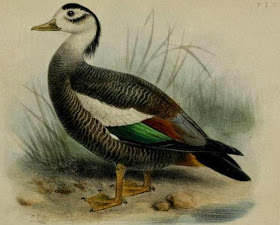Beth is two years into a part-time PhD, funded by The Wildfowl and Wetlands Trust (WWT) examining demographic patterns in the world's wildfowl. She is supervised by Stu, along with Dr Ed Harris (MMU) and Dr Geoff Hilton (WWT). Here, she introduces her study and some of her initial findings about the biases in our knowledge of the world's wildfowl.
 |
| Drawing: Iris Aspinall Priest, @Iris_Priest |
 |
| Barnacle Geese Branta leucopsis: Least Concern. Photo:
Richard Taylor-Jones |
Wildfowl species depend on wetlands
throughout various parts of their life cycle; this dependency is a major issue,
as many wetlands are under serious threat. With nearly 20% of wildfowl species threatened
with extinction and many declining wildfowl populations found in Asia and
Africa, the most threatened wildfowl species may have severely limited
knowledge. The trajectory of wildfowl populations is determined by
demographics: productivity, survival, immigration and emigration. Combining
demographic data with population assessments in the field is key to improving
our understanding of wildfowl population trajectories.
 |
| Blue Duck Hymenolaimus
malacorhynchos:
Endangered. Photo: Richard Taylor-Jones
|
 |
The
endemic Hawaiian Goose or Nene
Branta
sandvicensis: Vulnerable is
recovering through management interventions. Photo: Richard Taylor-Jones |
The aim of my research is to identify demographic rates for poorly-studied species; to understand how demographic variation contributes to population change and extinction risk; and ultimately, to inform management strategies for wildfowl species.
 |
| There have been no confirmed
records of the Crested Shelduck Tadorna
cristata since 1964.
The species is listed as Critically Endangered and
just may still occur in the wild. Painting:
Joseph Smit.
|
The
first stage of the research has investigated
the distribution of wildfowl demographic research outputs. Over 2000 published papers have been collated and the
demographic information extracted. Strong taxonomic, geographic and demographic
biases are apparent in published wildfowl demographic research, with consequent
substantial knowledge gaps, despite wildfowl being one of the better-studied groups.
Over 80% of wildfowl species had at least one
demographic research output and North America and Europe contributed to more
than 80% of the research output. However, a high proportion of wildfowl species
had very little information: over 50% of taxa had 10 or fewer demographic outputs. Productivity
measures were the most well studied of the demographic traits. Nearly half of the published
research has involved just 10 species from 7 genera - Mallard Anas platyryhnchos, Northern Pintail Anas
acuta, Canada
Goose Branta canadensis, Common Eider Somateria
mollissima, Common Teal Anas crecca, Snow Goose Anser
caerulescens, Wood Duck, Aix sponsa, Brent Goose Branta bernicla,
Mute Swan Cygnus olor, and Tufted
Duck Aythya fuligula. All species found in North America and Europe have
been studied (75 species).
 |
| Common Eider Somateria
mollissima: Least Concern. Photo: Richard Taylor Jones |
The next stage of my research asks
whether we can use this large body of information on North American and
European species to make inferences about the demography of poorly-studied
species. The life histories of birds have been widely studied to develop
theories to explain patterns in life history traits. This has led to a large
body of research to explain and understand how avian traits covary. Can we exploit these relationships to
predict traits for poorly-studied taxa? The next stage of my research will use
intrinsic and extrinsic factors to examine trait covariation, and develop a predictive
demographic model to produce surrogate rates. More on this will follow soon.
If you have any demographic information
on any wildfowl species, please email b.roberts@mmu.ac.uk or follow on
twitter @duckgirl73.



No comments:
Post a Comment